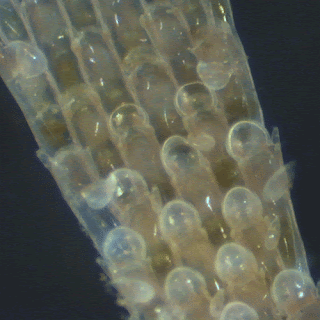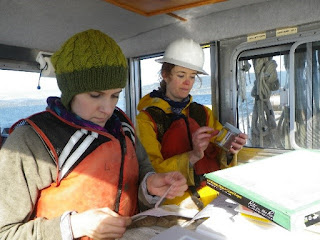Eyes Under Puget Sound's "Critter of the Month"
No matter the season, moss abounds in the forests, sidewalk
crevices, and rooftops of the Pacific Northwest. But did you know there is also
“moss” growing under the sea?
Stuck on you
Moss animals, or bryozoans, are actually animals in a plant
disguise! They can be found attached to hard surfaces like rocks or pilings –
you will often see tufts of them on floating docks or small white patches of
them encrusting kelp fronds. Although our Marine
Sediment Monitoring Program typically samples soft sediments, we
occasionally collect rocks, sticks, or shells with bryozoans attached.
Nature’s undersea carpet
A bryozoan’s intricate patterns aren’t just for show – if you look at one under a microscope, you will see that it isn’t just one individual organism, but a colony of many tiny animals called zooids. Most bryozoans produce calcium carbonate compartments to house their zooids, similar to the polyps in a coral colony. However, the delicate structures are too flimsy to form reefs, so scientists refer to a group of bryozoans as a “thicket” instead.Teamwork makes the dream work
Although zooids are separated by walls, they maintain constant contact with their neighbors, exchanging nutrients and other fluids through the tiny holes or tubes connecting their “houses.”- Ancestrula – the parent zooid, which settles as a larva to form a new colony. The colony expands outward as new zooids bud off asexually.
- Kenozooids – primitive zooids that attach the colony to a hard surface, fill gaps, and provide structural support.
- Autozooids – responsible for feeding and digestion. Each contains a feeding unit called the polypide, made up of the gut and a retractable crown of tentacles called the lophophore. The lophophore filters food particles from the water.
- Vibracula – have long hairs or bristles thought to keep the colony clean.
- Ooecia – specialized for brooding eggs.
- Avicularia – modified zooids thought to be responsible for defense.
Angry birds
 |
| Avicularia of Bugula californica in action! The pecking movements of the avicularia are thought to deter predators. |
Even though this plant-like colony is stuck in one place, it
can still defend itself from predators like nudibranchs and fish. The avicularia
– derived from Latin for “little bird” because of their resemblance to bird
heads – have been theorized to deter predatory grazing with their
“pecking” movements. This “pecking” begins when tiny sensory hairs inside the
beaks detect a disturbance. (See the avicularia of Bugula californica
in action, right!) The function of these zooids has not been extensively studied, but
you can certainly get an Alfred Hitchcock vibe just from looking at all those
sharp beaks (that actually open and close). Let’s see the moss in your lawn do
that!
Acid test
As climate change and ocean acidification threaten to impact
the temperature and chemistry of our oceans, scientists wonder if the effects
will be felt by animals like bryozoans. Researchers in New Zealand are testing
whether bryozoans will have a harder time obtaining carbonate from the water
around them to build their skeletons when ocean conditions become more acidic. Will
these mossy creatures become some of the newest sentinels for environmental
change?
By: Dany Burgess & Angela Eagleston, Environmental
Assessment Program
Critter of the Month
 Our
benthic taxonomists, Dany and Angela, are scientists who identify and count
the benthic (sediment-dwelling) organisms in our samples as part of our Marine
Sediment Monitoring Program. We are tracking the numbers and types of
species we see in order to understand the health of Puget Sound and to detect
any changes over time.
Our
benthic taxonomists, Dany and Angela, are scientists who identify and count
the benthic (sediment-dwelling) organisms in our samples as part of our Marine
Sediment Monitoring Program. We are tracking the numbers and types of
species we see in order to understand the health of Puget Sound and to detect
any changes over time.
Dany and Angela share their discoveries by bringing us a
Benthic Critter
of the Month. These posts will give you a peek into the life of Puget
Sound’s least-known inhabitants. We’ll share details on identification,
habitat, life history, and the role each critter plays in the sediment
community. Can't get enough benthos? See photos from our Eyes
Under Puget Sound collection on Flickr.



No comments:
Post a Comment